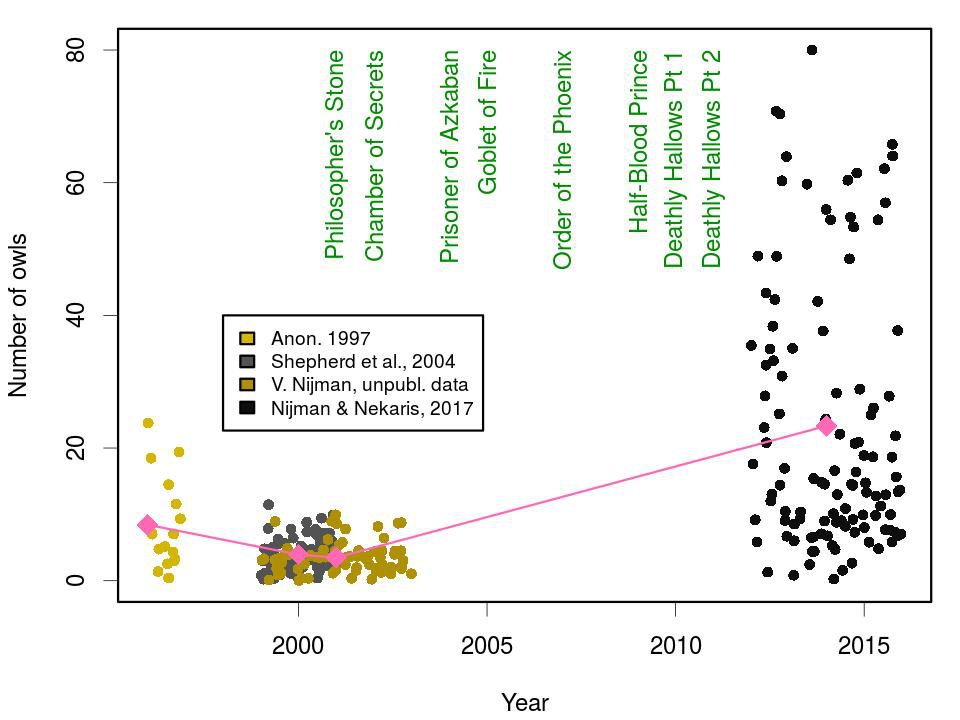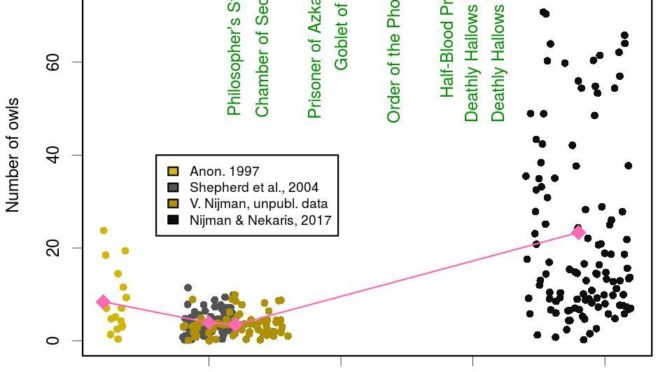Harry Potter and Owl Trade
Since the 1990s, the Little Fireface Project team has been conducting surveys in Java’s notorious animal markets. In 2017, during the 20 year anniversary of the publication of the Harry Potter books, we wrote a paper analysing the impact of the books on the owl pet trade in Indonesia. This paper is available open access via the journal Global Ecology and Conservation and is called The Harry Potter Effect: The rise in trade of owls as pets in Java and Bali, Indonesia.

Works
Our research brought vital attention to this sad and growing trade. The work was covered in more than 100 media outlets, and in many languages including:
- Nature – Has Harry Potter mania cursed Indonesia’s owls?
- Forbes – Is the Harry Potter Effect a Curse for Owls in Indonesia?
- The Guardian – Asia’s Harry obsession poses threat to owls
- Daily Mail – Why Harry Potter spells disaster for Indonesia’s ghost owls: Illegal trade threatens birds as fans copy the boy wizard
- Inside Science – “Burung Harry Potter” Owls found in Indonesian maret
- Mongabay – Harry Potter may have sparked illegal owl trade in Indonesia
- Konbini – People’s Obsession With Harry Potter May Be driving Owl Species Into Extinction
- Business Insider – “Harry Potter” has sparked huge demand for pets owls in Asia – and environmental campaigners are worried
- NextShark – “Harry Potter” Fans are Now a Threat to wild Owls in Asia, Study Finds
- Financial Tribune – Harry Potter Series Linked to Illegal Owl Trade
- Scroll.in – The harry Potter craze may have sparked illegal trade in pet owls in Indonesia
- Science – Did Harry Potter Create A Demand For Pet Owls In The UK?
- Tribun Medan – Harry Potter Tenar, tapi jadi Kutukan bagi Burung Hantu Indonesia, Ini Penjelasannya
Abstract
Below you can read the abstract from our study:
Hundreds of species of wild-caught birds are offered for sale in the bird markets of Java and Bali, Indonesia, to meet the demand for the largely-domestic pet and songbird trade. In the past, owls were offered only in very small numbers in these bird markets but since the release of the Harry Potter series in Indonesia in the early 2000s their popularity as pets has increased. Whereas in the past owls were collective known as Burung Hantu (“Ghost birds”), in the bird markets they are now commonly referred to as Burung Harry Potter (“Harry Potter birds”). We made a retrospective quantitative assessment of the abundance of owls in the bird markets (1979–2010) and conducted 109 surveys in 20 bird markets in 2012–2016 to quantify owls in trade. In the 1980s, 1990s and early 2000s owls were rarely recorded in Indonesia’s bird markets, typically one or two and up to five per survey, and frequently no owls were recorded at all. The trade was largely confined to small scops owls. In the late 2000s more species were offered for sale, including barn and bay owls, and larger owl species such as wood-owls, eagle-owls and fish-owls; typically 10 + owls were observed per survey. In recent years, the number of owl species increased even more, and on average we recorded 17 owls per survey, yielding a total of 1810 owls, and in >90% of the surveys owls were present. In the larger bird markets in Jakarta and Bandung typically 30 to 60 owls are on offer of up to 8 species at a time. The number of owls as a proportion of all birds in the markets increased from <0.06% prior to 2002 to >0.43% post 2008, suggesting a delayed Harry Potter effect. Over this period, common species have become cheaper and less common ones have become more expensive. The owls are largely, if not exclusively, wild-caught and are sold into the domestic pet market. The release of Harry Potter films and novels in Indonesia coincided with the rise of the Internet and social media and, with some delay, the emergence of pet owl interest groups on Java and Bali, thus preventing us to demonstrate a causal Harry Potter effect on the owl trade. The overall popularity of owls as pets in Indonesia has risen to such an extent that it may imperil the conservation of some of the less abundant species. Inclusion of owls on Indonesia’s protected species list, alongside all diurnal raptors, may be a first step to mitigate the negative effects of this emerging trend

